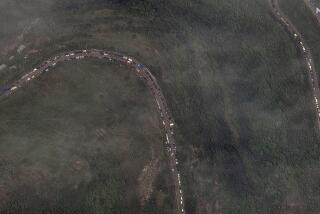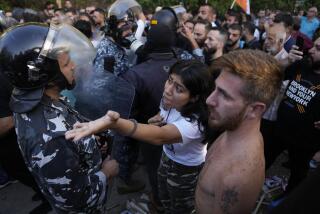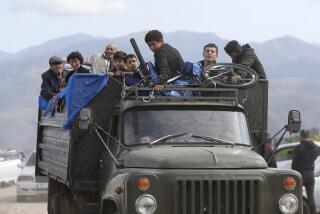CAUCASUS : Morale Slips as Armenians Suffer in Cold : Times get tougher as economy grinds to a halt. Parents send children to Moscow to keep warm.
- Share via
YEREVAN, Armenia — Armen Grigorian, a 32-year-old presidential adviser, tramped home on an icy pavement. The unlit street beside him was almost bereft of traffic because there is no fuel here. He bought his supper from a stand because most shops suffer shortages; a bottle of vodka in his pocket cost almost as much as the president’s monthly wage.
“For us, gasoline no longer has a smell--it’s an aroma,” said Grigorian, picking his way up a staircase with a friend’s flashlight into a frigid apartment, where the only source of heat is a hot plate--when the power is on briefly.
“This is our fourth winter without central heating at home,” he said. “When it used to get cold, it didn’t feel cold because the houses were warm. Now the trouble is you feel cold all the time, even in bed.”
Although Armenians continue to struggle, times have gotten even tougher in this nation of 3.3 million, landlocked in the Caucasus mountains.
Armenia already had endured a string of misfortunes, including a 1988 earthquake that killed about 25,000 people and the collapse of the Soviet economic network that had ensured that this former republic would receive much of its supplies.
But now the inexperienced leaders of this 1-year-old independent republic are grappling with blockades and other woes, seemingly on all sides.
The blockades mostly stem from Armenia’s fierce battles with Azerbaijan over the disputed enclave of Nagorno-Karabakh. Muslim Azerbaijan has reduced Christian Armenia’s supplies of natural gas to a minimum; it has pressured its ally Turkey to bar electricity or non-humanitarian supplies from crossing the Turkish border into Armenia.
A land route from Iran is not yet fully open, and bandits infest routes through Georgia; a 140-truck convoy, sent from Armenia to get sugar, lost half its cargo to Georgian brigands. Tankers sent by rail or road with petroleum products have sustained similar losses.
Meantime, in Armenia, morale is slipping. Almost all factories have been closed, and the economy has ground to a halt. Diplomats estimate that only 10% to 15% of Armenians are employed. Schools are closed until spring.
Those Armenians who can and do try to leave face problems as air traffic can be delayed up to a week; planes take off with passengers standing in the aisles. “People are even sending their children to Moscow for the winter, just to keep them warm,” one Armenian said.
To draw international attention to Armenia’s plight, President Levon Ter-Petrosyan declared a national disaster on Dec. 7 and appealed for emergency aid. He said 30,000 could die if no help arrives. Although diplomats and aid workers say his figures may be high, there is real hardship here and some discontent with Ter-Petrosyan, 47, an academic democratically elected a year ago.
The reasons for the unhappiness are clear in Armenia, which had one of the highest standards of living in the former Soviet Union. The United Nations said that 70% of Armenians now live below subsistence levels; the number of mothers who can nurse their own babies has been halved in the past year; there is almost no baby food to be had. The United Nations has increased its existing emergency programs to care for 92,500 refugees and people displaced by war and the earthquake.
The United States has tried to help the Armenians by improving communications with Turkey and Georgia and offering financial aid. The Americans also have shipped more than 100,000 tons of wheat and 20,000 tons of butter, oil, lentils and other food, said Suzanne Olds, a representative for the U.S. Agency for International Development. “The bread crisis (in Armenia) is over. Now they have 15 days’ reserves. Now the problem is fuel,” Olds said.
More to Read
Sign up for Essential California
The most important California stories and recommendations in your inbox every morning.
You may occasionally receive promotional content from the Los Angeles Times.












